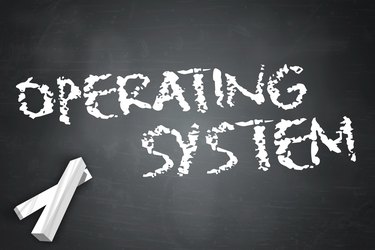
Closed-source operating systems use code that is proprietary and kept secret to prevent its use by other entities. Traditionally, they are sold for a profit. Open-source operating systems use code that is freely-distributed and available to anyone to use, even for commercial purposes. Both types of operating systems have advantages.
Pricing
Video of the Day
Open-source operating systems such as Linux or FreeBSD do not cost anything, through some Linux companies, such as Red Hat, provide supported versions for a fee. Closed-source operating systems can either be free or offered for a price. Microsoft Windows comes preinstalled on many new computers; though you do not have to pay separately for it, the cost of the Windows license is figured into the price by the computer manufacturer, who pays Microsoft a bulk licensing fee for all their preinstalled copies of Windows. Windows can be purchased separately for computers without an operating system or as an upgrade to a previous version of Windows. OS X is also preinstalled on new Macs, with small fees typically charged for upgrades, though the Mavericks upgrade was free.
Video of the Day
Development
With closed source operating systems, the development costs are typically paid for by the company itself, who hires the developers and determines the direction of the project. This offers the benefit of a professional team of developers and guaranteed performance, which is essential for certain software packages. In the open-source community, the direction of a project is determined either by a board of directors, the community or individuals. Development costs are generated through a combination of donations from companies and individuals, or through indirect methods such as developers who are paid by corporations to work on open-source code. For instance, IBM and Red Hat, who sell Linux systems and Linux support, both pay employees to develop open-source Linux code, which benefits not only their open-source Linux variants, but other Linux projects as well. Apple also pays its developers to work on the BSD-variant Darwin, which is the base for its OS X software. Open source-projects are free to choose their direction and are not driven by profitability.
Source Availability
The manufacturers of closed-source operating systems, such as Windows or OS X, will not allow their programming code to be viewed by most third parties. If there is a vulnerability in the code, it must be discovered by the company itself; because there are a limited number of developers assigned to the project, it is possible that the vulnerability will go unnoticed. In open-source operating systems, the code is viewable by anybody. Theoretically, this means that many more people will be able to see the programming code, offering the potential to catch any vulnerabilities quicker than with closed-source operating systems. In practice, this is not always the case. Since the developers may be volunteers who work on what they are interested in or employees paid by a corporation to work on a specific piece of code, vulnerabilities in other portions of the code may still go unnoticed.
Examples
Examples of computer open-source operating systems include Linux, FreeBSD and OpenSolaris. Closed-source operating systems include Microsoft Windows, Solaris Unix and OS X. Older closed-source operating systems include OS/2, BeOS and the original Mac OS, which was replaced by OS X. On mobile and tablet systems, closed-source operating systems include Windows Phone, iOS and the Symbian OS that is used by BlackBerry. Android is based on the open-source Linux OS, though it has many proprietary, closed-source extensions. The Linux-based Firefox OS is an example of a fully open-source mobile OS, though it has yet to gain significant popularity.
- Red Hat: Store
- Microsoft Store: Windows 8
- Apple: OS X
- Ars Technica: Red Hat and CentOS Become Voltron, Build Free Operating System Together
- ZDNet: IBM and Linux: The Next Billion Dollars
- Apple: Mac Technology Overview
- Open Source Initiative: Frequently Asked Questions
- Ars Technica: Heartbleed Developer Explains OpenSSL Mistake That Put Web at Risk